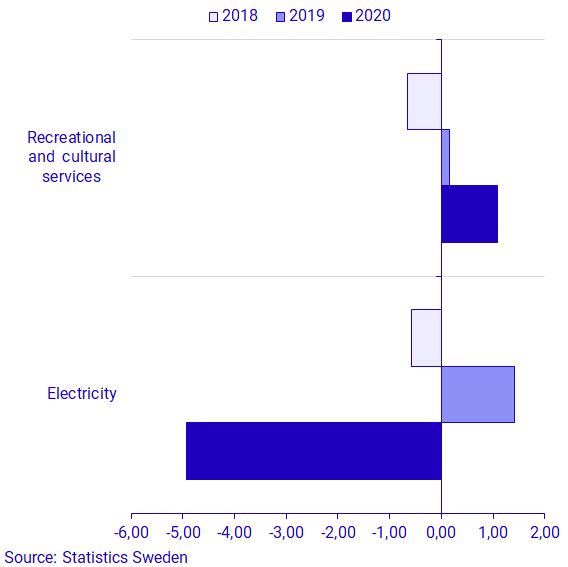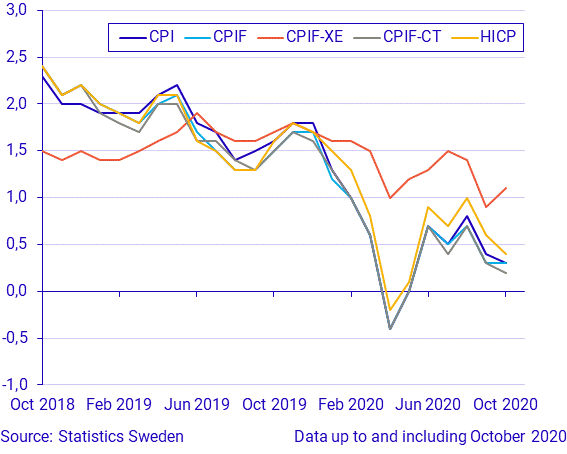Consumer Price Index (CPI), October 2020
Inflation rate was 0.3 percent in October 2020
Statistical news from Statistics Sweden 2020-11-12 9.30
The inflation rate according to the CPIF (Consumer Price Index with fixed interest rate) was 0.3 percent in October 2020. This is an unchanged inflation rate compared with September. Lower prices on electricity accounted for the main contribution to the CPIF monthly change, which, in total, remained unchanged from September to October.
In brief
- Prices on electricity returned to levels similar to before the summer
- A number of small price increases in October offset the downturn in electricity prices
- The inflation rate was again affected by continued low prices on package holidays
- The inflation rate according to the CPIF, excluding energy, rose from 0.9 to 1.1 percent
- The same product groups as in September were imputed due to the coronavirus pandemic, and accounted for 1.0 percent of the basket
| Index Numbers | Monthly changes, percent | Annual changes, percent | |
|---|---|---|---|
| CPI (1980=100) | 336.97 | ‑0.1 | 0.3 |
| CPIF (1987=100) | 220.38 | 0.0 | 0.3 |
| CPIF-XE (1987=100) | 208.99 | 0.2 | 1.1 |
Lower prices on electricity in October
The CPIF remained unchanged between September and October. In the corresponding period a year ago, the CPIF was also unchanged.
The largest contribution to the CPIF monthly rate came from lower prices on electricity. In October, prices fell on electricity after increases in both August and September. This decrease was partly offset by higher prices for recreational and cultural services, where the main upward contribution came from price increases on the practice of sporting services. Minor price increases were also noted in a number of product groups, overall contributing to an unchanged monthly rate.
The table below shows changes on a monthly basis and contributions to the CPIF based on the goods and services that had the largest impact on the CPIF in October 2020. The results are reported per COICOP category; COICOP refers to the United Nations classification of household consumption expenditure.
| Category (Coicop) | Monthly changes, percent | Contribution to CPIF Monthly change, percentage points |
|---|---|---|
| Electricity (04.5.1) | ‑4.9 | ‑0.2 |
| Recreational and cultural services (09.4) | 1.1 | 0.1 |

Seasonal patterns and temporary price changes
Price changes on goods and services may be seasonal or temporary. The figure above shows the monthly changes this year and in the two most recent years, for the goods and services with the largest impact on the CPIF monthly change.
Most of the price changes in October were so small that they did not individually contribute to the total CPIF monthly change. The main exception was electricity prices, which fell this month. Prices on electricity also fell in October 2018, but not to the same extent as in this period. Electricity prices have been relatively low throughout the year. Despite upturns in recent months, in October, prices fell again to a level similar to the one in June.
The second exception was recreational and cultural services, in which the contribution came mainly from price returns for the practice of sporting services. During the coronavirus pandemic, there have been several campaigns for different exercise and sporting services. However, in October, prices on offerings have largely returned to normal.
Prices on package holidays remained low
The inflation rate according to the CPIF, that is, the change in the CPIF over the past 12-month period, was 0.3 percent in October 2020. This means that the inflation rate is unchanged from September.
Higher prices on food and non-alcoholic beverages made an upward contribution to the change in the CPIF in October. Prices also increased on furnishings and household goods, as well as housing costs.
This increase was mainly offset by falling prices on electricity. Downward contributions also came from lower prices on fuel, in particular petrol. Other downward contributions came from price declines on telephone equipment and package holidays. Despite a marginal price change between September and October, prices on package holidays remained low compared with the same period a year ago. In October, the range of destinations was more or less the same as last year, albeit with fewer departures and fewer travelers.
The inflation rate according to the CPIF, excluding energy, was 1.1 percent in October, up from 0.9 percent in September.
| Category (Coicop) | Yearly change, percent | Contribution yearly change CPIF percentage points |
|---|---|---|
| Food and non-alcoholic beverages (01) | 1.5 | 0.2 |
| Electricity (04.5.1) | ‑11.2 | ‑0.5 |
| Rented and housing co-operative dwellings: rent incl. heating (04.S) | 1.6 | 0.2 |
| Housing (04.x) | 3.1 | 0.2 |
| Furnishings and household goods (05) | 2.3 | 0.2 |
| Fuel (07.2.2) | ‑10.9 | ‑0.3 |
| Telephone equipment (08.2) | ‑9.8 | ‑0.2 |
| Package holidays (09.6) | ‑16.9 | ‑0.2 |
| Misc. Goods and services (12) | 2.6 | 0.2 |
Other measures of inflation
Statistics Sweden calculates different inflation measures for different purposes. The CPIF is the Riksbank’s target variable, while the CPI is the measure used for purposes of compensation.

Effects of the coronavirus pandemic on calculations
Measures in response to the coronavirus pandemic have led Swedish consumers to adapt parts of their consumption. In some cases, stores have closed, but it remains possible to purchase products elsewhere. In other cases, consumption has ceased completely. These developments make calculating the consumer price index particularly challenging.
Due to a lack of consumption, prices on tickets to sporting events, international travel and admission tickets for entertainment have been imputed to some degree. In total, 1.0 percent of the CPI basket was imputed in October based on the year-on-year change in non-imputed product groups. For further information about measurement issues related to the coronavirus pandemic, follow the link below.
Meausurement issues related to the coronavirus pandemic (pdf)
Definitions and explanations
The CPIF shows the same price trend as the CPI, but without the direct effects of a changed monetary policy. The CPIF is the Riksbank’s target variable for the inflation target.
The CPIF excluding energy (CPIF-XE) and the CPIF with constant tax (CPIF-CT) are two other measures of inflation produced by Statistics Sweden on behalf of the Riksbank. In the CPIF-XE, energy products are excluded from the CPIF, while in the CPIF-CT the taxes and subsidies associated with the products in the CPIF are kept constant.
The HICP (Harmonised Index of Consumer Prices) is produced by all EU Member States. This measure has a somewhat smaller coverage than the CPI and the CPIF, mainly because parts of households’ housing costs are omitted.
Next publishing will be
2020-12-10 at 9:30.
Statistical Database
More information is available in the Statistical Database
Feel free to use the facts from this statistical news but remember to state Source: Statistics Sweden.
